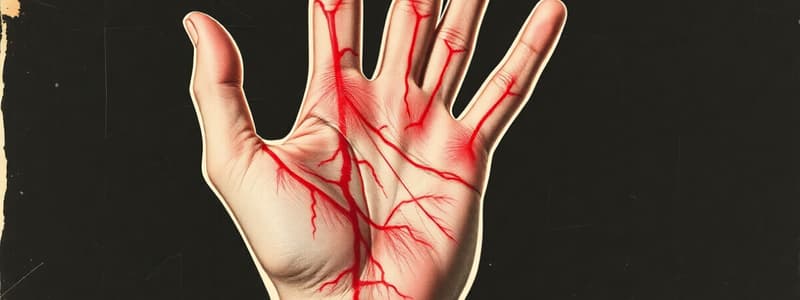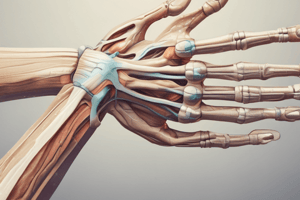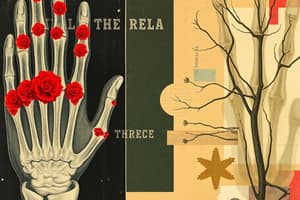Podcast
Questions and Answers
What is a primary clinical characteristic of ulnar nerve palsy?
What is a primary clinical characteristic of ulnar nerve palsy?
- Metacarpophalangeal (MCP) flexion, interphalangeal (IP) extension, and thenar muscle wasting
- Metacarpophalangeal (MCP) hyperextension, interphalangeal (IP) flexion, and hypothenar muscle wasting (correct)
- Metacarpophalangeal (MCP) flexion, interphalangeal (IP) flexion, and hypothenar muscle hypertrophy
- Metacarpophalangeal (MCP) hyperextension, interphalangeal (IP) extension, and thenar muscle hypertrophy
In ulnar nerve palsy, the imbalance between which muscle groups contributes to the 'claw hand' deformity?
In ulnar nerve palsy, the imbalance between which muscle groups contributes to the 'claw hand' deformity?
- Spastic extrinsic muscles and atrophied intrinsic muscles
- Atrophied extrinsic muscles and spastic intrinsic muscles
- Weakened extrinsic muscles overpowering strong intrinsic muscles
- Strong extrinsic muscles overpowering weakened intrinsic muscles (correct)
After carpal tunnel syndrome, what condition is identified as the second most common neuropathy of the upper extremity?
After carpal tunnel syndrome, what condition is identified as the second most common neuropathy of the upper extremity?
- Ulnar nerve entrapment (correct)
- Radial nerve palsy
- Median nerve compression at the elbow
- Brachial plexus injury
Which of the following motor function deficits is specifically associated with ulnar nerve palsy?
Which of the following motor function deficits is specifically associated with ulnar nerve palsy?
An ulnar nerve lesion located closer to the elbow is specifically referred to as:
An ulnar nerve lesion located closer to the elbow is specifically referred to as:
Flashcards
Ulnar Nerve Palsy
Ulnar Nerve Palsy
A condition resulting in loss of sensory and motor function due to ulnar nerve injury.
Claw Hand
Claw Hand
A clinical sign where the fingers flex at the IP joints and extend at the MCP joints due to muscle imbalance.
Intrinsic vs. Extrinsic Muscles
Intrinsic vs. Extrinsic Muscles
Intrinsic muscles (e.g., interossei) are weakened while extrinsic muscles (e.g., extensor digitorum) remain strong in ulnar nerve palsy.
Cubital Tunnel Syndrome
Cubital Tunnel Syndrome
Signup and view all the flashcards
Guyon's Canal Syndrome
Guyon's Canal Syndrome
Signup and view all the flashcards
Study Notes
Ulnar Nerve Palsy ("Claw Hand")
- Ulnar nerve palsy can cause loss of sensory and motor function.
- Nerve injury weakens muscles, creating an imbalance between strong extrinsic muscles (e.g., extensor digitorum) and weakened intrinsic muscles (e.g., interossei and lumbricals).
- This imbalance is clinically characterized by metacarpophalangeal (MCP) hyperextension, interphalangeal (IP) flexion, and wasting of the hypothenar muscles.
- The thumb cannot be adducted.
- Ulnar nerve entrapment is the second most common upper extremity neuropathy after carpal tunnel syndrome.
- Ulnar nerve lesions can occur high (closer to the elbow), causing cubital tunnel syndrome, or low (closer to the wrist), causing Guyon's canal syndrome.
Studying That Suits You
Use AI to generate personalized quizzes and flashcards to suit your learning preferences.




